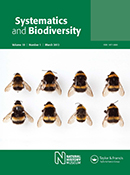April 2, 2012
Scientists say worldwide collections, existing experts and technology make charting 10 million species in less than 50 years achievable; a necessary step to sustain planet’s biodiversity
 TEMPE, Ariz. – An ambitious goal to describe 10 million species in less than 50 years is achievable and necessary to sustain Earth’s biodiversity, according to an international group of 39 scientists, scholars and engineers who provided a detailed plan, including measures to build public support, in the March 30 issue of the journal Systematics and Biodiversity.
TEMPE, Ariz. – An ambitious goal to describe 10 million species in less than 50 years is achievable and necessary to sustain Earth’s biodiversity, according to an international group of 39 scientists, scholars and engineers who provided a detailed plan, including measures to build public support, in the March 30 issue of the journal Systematics and Biodiversity.
“Earth’s biosphere has proven to be a vast frontier that, even after centuries of exploration, remains largely uncharted,” wrote the authors, who include biodiversity crusaders Edward O. Wilson and Peter H. Raven.
“Exploring the biosphere is much like exploring the universe,” the authors argued. “The more we learn, the more complex and surprising the biosphere and its story turn out to be.”
By most estimates, about 2 million of Earth’s species are known, with about 18,000 new plants and animals discovered each year. Experts estimate at least 10 million species on Earth are yet to be discovered or accurately classified. These species are tiny, large, buried, hidden in collections, or in plain sight.

